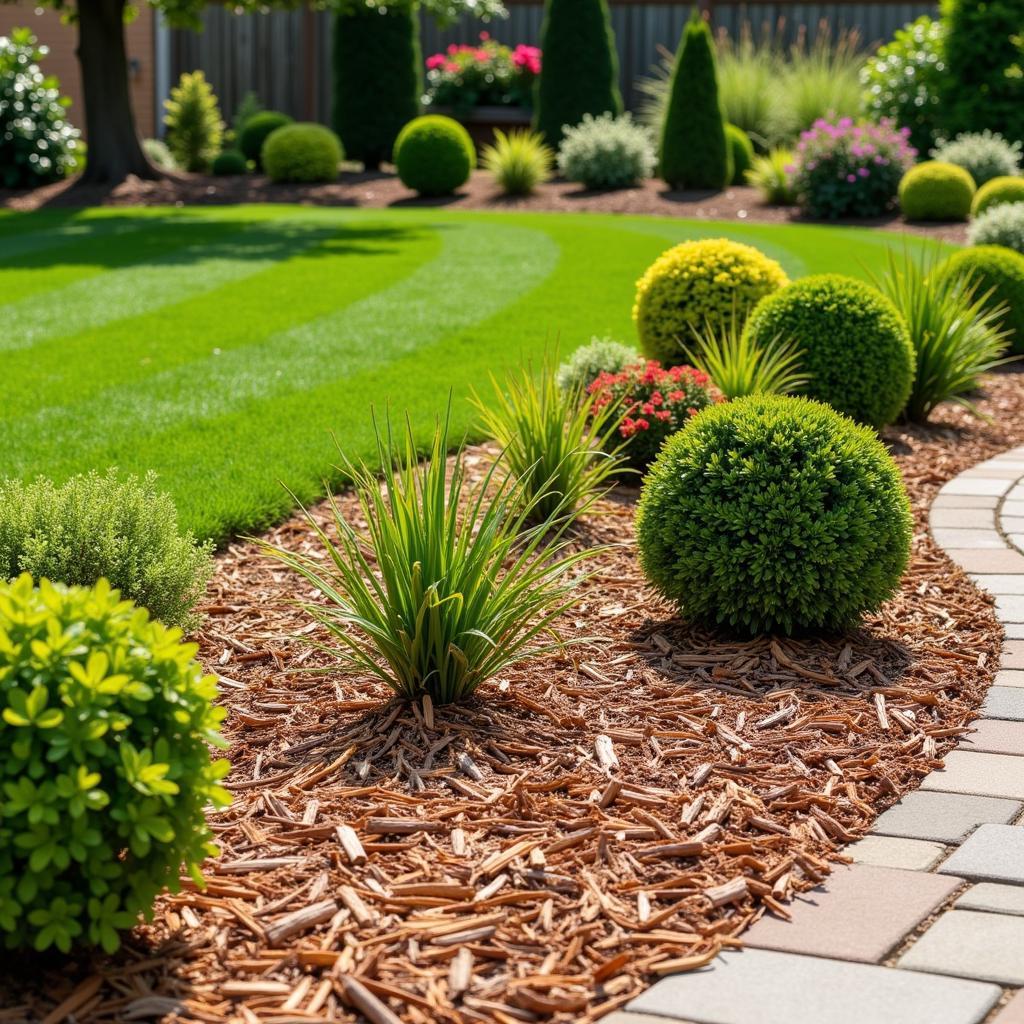Cedar mulch, prized for its aromatic qualities and pest-repelling properties, is typically a rich reddish-brown when fresh. This color can vary slightly depending on the specific type of cedar tree the mulch is derived from, as well as the age of the mulch. Understanding the color variations of cedar mulch and how it changes over time can help you make the best choice for your landscaping needs.  Fresh cedar mulch displaying a rich reddish-brown color
Fresh cedar mulch displaying a rich reddish-brown color
Understanding the Natural Color of Cedar Mulch
The characteristic reddish-brown color of cedar mulch comes from the natural pigments within the cedar wood itself. Western Red Cedar, a popular source for mulch, boasts a particularly vibrant hue. However, other cedar varieties can range from a lighter, almost golden brown, to a deeper, more chocolatey brown. The age of the cedar wood also plays a role; freshly chipped mulch will be more vibrant than older mulch, which tends to fade over time. This natural fading process is normal and doesn’t necessarily indicate a loss of the mulch’s beneficial properties.
Choosing the right color mulch can significantly enhance your garden’s aesthetic. For more information on selecting the perfect mulch color, check out what color of mulch is best.
Factors Influencing Cedar Mulch Color
Several factors influence the color of cedar mulch. These include:
- Species of Cedar: Different cedar species have varying natural pigmentations.
- Age of the Mulch: Fresh mulch is typically more vibrant than aged mulch.
- Exposure to Sunlight: Sunlight can cause the mulch to fade over time.
- Moisture Levels: Consistent moisture can lead to a darker appearance.
How Cedar Mulch Color Changes Over Time
Over time, cedar mulch will naturally weather and fade. The reddish-brown color will gradually transition to a silvery-gray. This is a natural process caused by sun exposure and decomposition. While the color changes, the mulch continues to provide benefits to your plants, such as weed suppression, moisture retention, and temperature regulation. Knowing how long does mulch color last is crucial for planning your landscaping maintenance.
Maintaining the Color of Your Cedar Mulch
While the fading process is inevitable, you can take steps to prolong the vibrant color of your cedar mulch. These include:
- Applying a fresh layer of mulch annually.
- Avoiding overwatering, which can accelerate fading.
- Choosing a shaded area for mulch application if possible.
Choosing the Right Cedar Mulch for Your Garden
When selecting cedar mulch, consider the following factors:
- Desired Color: Choose a mulch that complements your existing landscaping.
- Intended Use: Consider the specific needs of your plants and soil.
- Budget: Cedar mulch can be more expensive than other types of mulch.
If you’re wondering can you use colored mulch in a vegetable garden, this resource can provide valuable insights.
 Cedar mulch applied around plants in a garden setting
Cedar mulch applied around plants in a garden setting
“Choosing high-quality cedar mulch is an investment in the health and beauty of your garden,” advises renowned landscape architect, Amelia Green. “The natural aroma and pest-repelling properties of cedar make it an excellent choice for a variety of landscapes.”
Conclusion
Cedar mulch typically starts as a reddish-brown and fades to a silvery-gray over time. Understanding this natural process and the factors that influence cedar mulch color will help you choose the best mulch for your garden and maintain its appearance. By selecting quality cedar mulch and implementing proper maintenance techniques, you can enjoy the aesthetic and practical benefits of this natural material for years to come. Remember, understanding what color is cedar mulch is the first step to creating a thriving and beautiful outdoor space.
FAQs
- What are the benefits of using cedar mulch? Cedar mulch suppresses weeds, retains moisture, regulates soil temperature, and repels insects.
- How often should I replace cedar mulch? Replenishing cedar mulch annually is recommended to maintain its appearance and benefits.
- Does cedar mulch attract termites? Contrary to popular belief, cedar mulch is naturally resistant to termites.
- Can I use cedar mulch around vegetable plants? Yes, cedar mulch is safe for vegetable gardens.
- Is cedar mulch more expensive than other types of mulch? Generally, cedar mulch tends to be slightly more expensive due to its desirable properties.
- Does the color of cedar mulch affect its effectiveness? No, the color change due to weathering does not diminish the mulch’s beneficial properties.
- Where can I buy high-quality cedar mulch? High-quality cedar mulch is available at most garden centers and home improvement stores.
Are you curious about other landscaping topics? Learn more about are fleas common in colorado or do pine trees change color.
For all your color and design needs, contact Color Box Hanoi! Call us at 0373298888, email us at [email protected], or visit our showroom at 86 Cau Giay, Hanoi. Our 24/7 customer service team is ready to assist you.